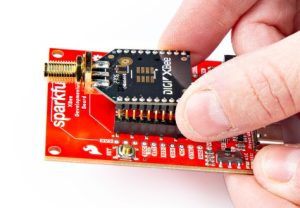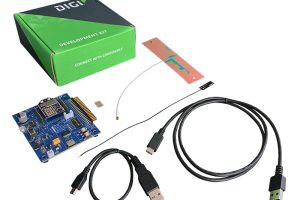Working with Digi XBee 3 RF modules, the idea is to combine the Digi XBee module platform with SparkFun’s Qwiic Connect system for quickly interfacing dev boards with sensors, LCDs, relays, and the like. It measures just 13 x 19mm.
And there’s Digi Remote Manager, for remotely managing the readings, with built-in Digi TrustFence security, identity, and data privacy features…
In the words of its makers, it brings “I2C-based rapid-prototyping tools to a wide range of users, from hobbyists to professional R&D developers, who are looking to integrate cellular IoT from sensor to cloud”.
SparkFun writes:
“This is a ‘kitchen sink’ development board that gives you access to the pin functionality of the XBee, includes two USB-C connectors for UART communication and firmware updates, a Qwiic connector for I2C capable sensors and peripherals, as well as Reset and D0 buttons and the ability to update firmware on the XBees that have cellular modules. There’s also a JST port for a battery to allow your project to be more on the go.”
SparkFun Digi XBee features
Features of the board include:
- On-board Digi XBee 3 micro form factor socket
- Configurable via XCTU or AT command
- AP63203 Buck converter (up to 2A)
- FT231XS USB to UART bridge
- 1x Qwiic connector
- Up to 6V supply voltage
- 3x indicator LEDs
- Reset and D0 buttons
- 2-pin JST charge circuit connector for single cell, LiPo batteries
The board was showcased at CES 2024 in January. It now costs $19.95 from the SparkFun website.
“We’re thrilled to collaborate with SparkFun,” said Bob Blumenscheid, Senior Product Marketing Manager at Digi International.
“We’re so well aligned in our visions when it comes to supporting developers with excellent building blocks that simplify the complexity of IoT projects and support rapid time-to-market. By combining pre-certified modules with code libraries and tools for configuration, testing, deployment and remote management, we can give developers the leg up they need to succeed.”
You can read more here, and find the board’s schematic here. And check out the video below for eight use cases – for Cellular IoT – using Digi XBee 3 and the SparkFun Digi XBee board. The cases include such things as noise monitoring and predictive maintenance:
Our Technology Editor has already covered this one, note, and you can read the news article here.
See also: DevBoard Watch – The ST-based Odyssey-STM32MP135D SBC
 Electronics Weekly Electronics Design & Components Tech News
Electronics Weekly Electronics Design & Components Tech News


